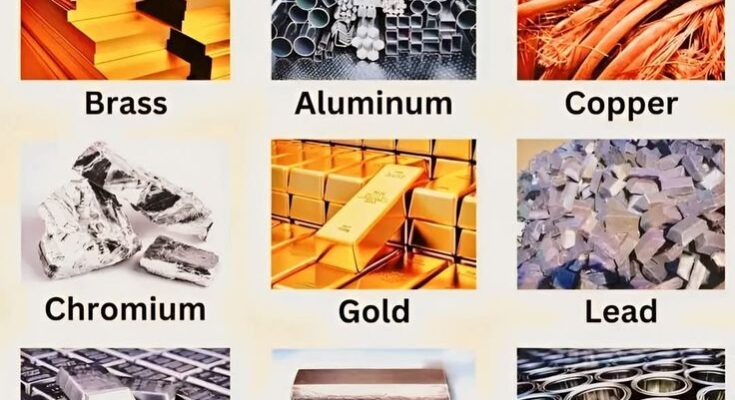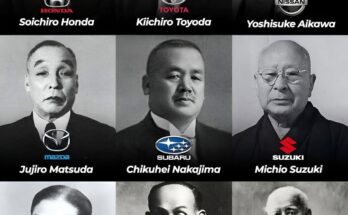Types of Metals: A Comprehensive Guide
Metals are fundamental materials that have shaped human civilization, from ancient tools to modern infrastructure. The image above showcases a diverse array of metals, each with unique properties, uses, and appearances. Below, we delve into the characteristics and applications of the 12 metals featured, providing a detailed overview for enthusiasts, professionals, and hobbyists alike.

1. Steel
Steel, depicted with its recognizable rebar form, is an alloy primarily composed of iron and carbon. Known for its exceptional strength and durability, steel is a cornerstone of construction, used in buildings, bridges, and reinforcement bars. Its versatility allows it to be molded into various shapes, making it indispensable in industrial applications.
2. Iron
The image shows iron in the form of nails and other small components. Iron is a foundational metal, often alloyed to create steel. Pure iron is relatively soft but highly magnetic, and it has been used historically for tools, weapons, and machinery. Its abundance and workability make it a key player in metallurgy.
3. Bronze
Bronze, displayed as vibrant orange rods, is an alloy of copper and tin. Renowned for its hardness and resistance to corrosion, bronze was one of the first alloys created by humans, marking the Bronze Age. Today, it is prized for sculptures, musical instruments, and marine hardware.
4. Brass
The golden-hued brass in the image highlights its warm, metallic sheen. An alloy of copper and zinc, brass is valued for its malleability and acoustic properties. It is commonly used in decorative items, musical instruments like trumpets, and fittings that require corrosion resistance.
5. Aluminum
Aluminum is shown as lightweight, silver-colored rods and sheets. This metal is lightweight yet strong, with excellent corrosion resistance due to a natural oxide layer. Widely used in aerospace, packaging (e.g., foil), and automotive industries, aluminum’s recyclability adds to its appeal.
6. Copper
The image features copper in its raw, reddish-brown form. Known for its excellent electrical and thermal conductivity, copper is essential in wiring, electronics, and plumbing. Its antimicrobial properties also make it useful in healthcare settings.
7. Chromium
Chromium appears as shiny, metallic chunks in the image. This hard, brittle metal is often used as a coating to enhance the corrosion resistance and aesthetic appeal of other metals, such as in chrome-plated car parts. It is also a key component in stainless steel.
8. Gold
Gold is showcased in its iconic bar form, gleaming with a rich yellow luster. A precious metal, gold is highly malleable and resistant to tarnish, making it a favorite for jewelry, coinage, and investment. Its use in electronics due to its conductivity is less visible but equally significant.
9. Lead
Lead is depicted as dull, grayish blocks. This dense, soft metal has been historically used in batteries, roofing, and piping, though its toxicity limits modern applications. Today, it is primarily found in specialized industrial uses under strict regulations.
10. Silver
Silver shines brightly in the image as polished bars. Valued for its stunning luster and high conductivity, silver is a precious metal used in jewelry, silverware, and electronics. Its antimicrobial properties also make it useful in medical devices.
11. Magnesium
Magnesium is shown as rough, silvery-white ingots. This lightweight metal is highly reactive and often alloyed with others to improve strength. It is used in aerospace, automotive parts, and even fireworks due to its bright flame when burned.
12. Tin
Tin appears as shiny, corrugated sheets in the image. This soft, malleable metal is resistant to corrosion and is commonly used to coat steel to prevent rust (e.g., tin cans). It also plays a role in soldering and the production of bronze.
13. Nickel
Nickel is presented as small, spherical pellets. This hard, silvery metal is resistant to corrosion and oxidation, making it ideal for alloying with steel (e.g., stainless steel) and in coinage. It is also used in batteries and electroplating.
14. Titanium
Titanium is shown as a rugged, metallic chunk. Known for its high strength-to-weight ratio and corrosion resistance, titanium is a favorite in aerospace, medical implants, and high-performance sports equipment.
15. Zinc
Zinc appears as corrugated sheets, often used for roofing. This bluish-white metal is highly corrosion-resistant and is widely used to galvanize steel, protecting it from rust. It also plays a role in alloys and as a dietary supplement.
Conclusion
This collection of metals highlights their diverse properties and applications, from structural steel to precious gold. Each metal contributes uniquely to various industries, reflecting humanity’s ingenuity in harnessing natural resources. Whether you’re an engineer, artist, or curious learner, understanding these metals opens the door to appreciating their role in our world. Explore further and experiment with these materials to unlock their full potential!



